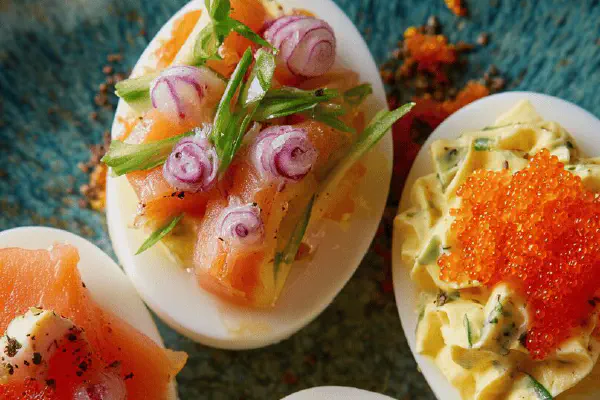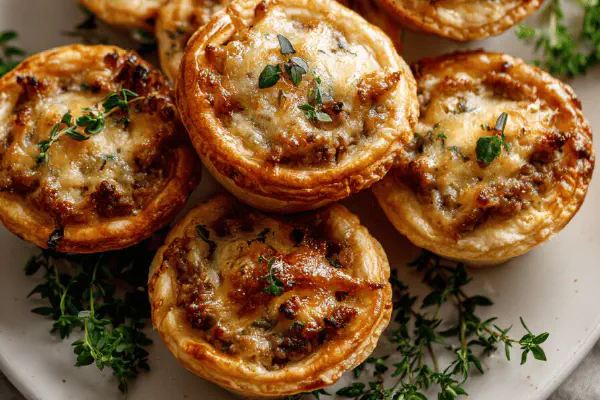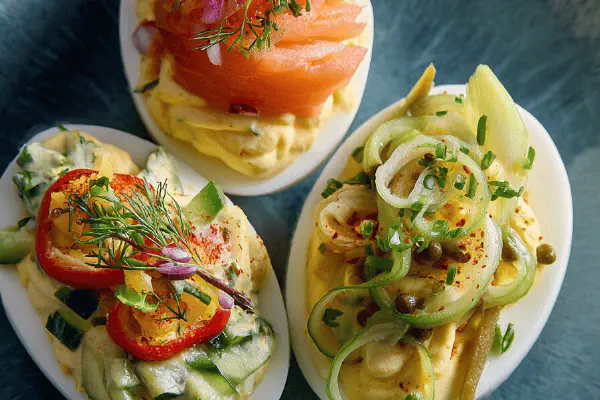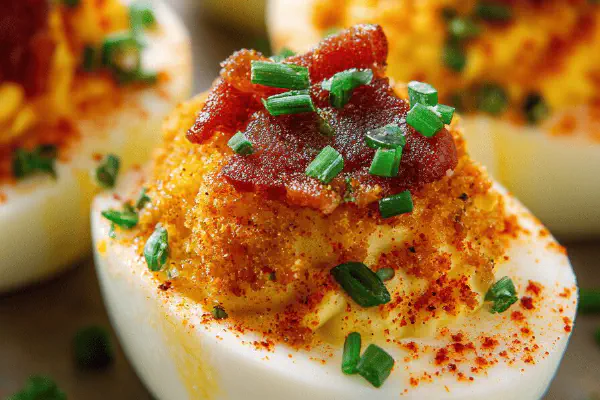Festive Deviled Egg Platter
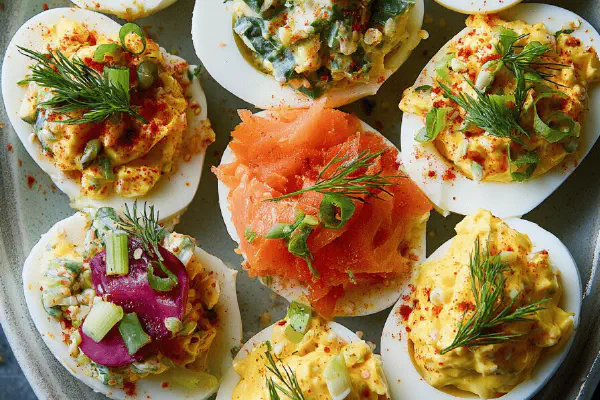
By Emma
Certified Culinary Professional
Ingredients
- 1 dozen large eggs
Eggs Deviled Blini Style
- 50 ml (3 1/2 tbsp) heavy cream whipped
- 7 ml (1 1/4 tsp) prepared horseradish
- 60 g (2 1/8 oz) smoked salmon strips rolled into tiny rosettes
- 25 ml (1 1/2 tbsp) mullet roe
- 25 ml (1 1/2 tbsp) roughly chopped dill
Eggs Deviled Sushi Style
- 50 ml (3 1/2 tbsp) mayonnaise
- 7 ml (1 1/4 tsp) wasabi paste
- 1 ml (just less than 1/4 tsp) toasted sesame oil
- 1 small Lebanese cucumber, cut in thin half moons
- 25 ml (1 1/2 tbsp) pickled ginger, pink variety
- 25 ml (1 1/2 tbsp) black or white sesame seeds
Eggs Deviled Sandwich Style
- 2 celery stalks, diced small
- 12 ml (2 1/2 tsp) olive oil
- 12 ml (2 1/2 tsp) white wine vinegar
- 10 ml (2 tsp) capers diced (swap for cornichons)
- 3 ml (3/4 tsp) chopped tarragon
- 25 ml (1 1/2 tbsp) plain yogurt
- 20 ml (1 1/3 tbsp) mayonnaise
- 6 ml (1 1/4 tsp) whole grain mustard
- 3 ml (3/4 tsp) granulated sugar
About the ingredients
Method
Prepare Eggs
- Set a steaming rack, like a folding steamer or marguerite, inside a large pot. Pour water just below rack base; no rinsing eggs before steaming — they hold flavor better with the natural bloom intact. Cover pot tightly and bring water to roiling boil. This prevents cracking from sudden heat and ensures steady steam.
- Lower cold eggs gently onto rack. Cover immediately, steam eggs for 7 minutes for set whites and jammy yolks - watch steam, not clock. Avoid overcooking which causes greenish yolk rings and sulfur smell. Listening for steady hissing steam is key.
- After steaming, plunge eggs into ice water bath without delay. Stops cooking fast; yolks stay creamy. Let rest 20 minutes at least. The cold bath also helps loosen shells, making peeling smoother - a common sticking point. Tap gently, peel under running cold water for easiest shell removal without pitting egg surface.
- Once peeled, pat dry. Halve lengthwise. Gain visual of firm whites with tender, moist yolks — not rubbery or chalky. Place halves on serving trays for final assembly.
Make Blini Style Filling
- Whip heavy cream in cold bowl till soft peaks. Fold in horseradish and salt sparingly, tasting as you go. Cream should hold light whip and sharp horseradish punch without watery separation. This creamy tang contrasts smoky salmon rosettes nicely.
- Layer smoked salmon rosettes, dollops of mullet roe, and chopped dill alongside halved eggs. Invite guests or yourself to spoon creamy mix into white cavities, topping with roe and herbs. Keeps textures lively and cross-flavor. Personal assembling gives a playfulness missed by premixing.
Make Sushi Style Filling
- In a small bowl, mix mayonnaise with wasabi paste and toasted sesame oil. Salt lightly; wasabi brings heat but don’t overpower. Check with fingertip dab - should tingle without burning.
- Spread cucumber half moons and pink pickled ginger around halved eggs. Sprinkle sesame seeds for crunch and nutty aroma. Keep these separate to prevent sogginess.
- Serve all components on a platter allowing hand assembly. The cold, crisp cucumber contrasts the creamy core beautifully.
Make Sandwich Style Filling
- Combine diced celery, olive oil, white wine vinegar, capers, and tarragon in a bowl. Season with salt and pepper. This brings crunch, acidity, and herbaceous freshness to the biting celery.
- In a separate smaller bowl, whisk plain yogurt with mayonnaise, whole grain mustard and sugar until smooth. Balances tart and sweet for that classic egg salad creaminess.
- Place celery mix and sauce on service dish next to halved eggs. Encourage mixing immediately before eating to maintain celery bite and sauce brightness.
Assembly Notes and Tips
- Don’t fill eggs too early; moisture seeps out, making whites soggy over time. Assemble just before serving or set components at table for guests to build their own.
- Swapping crème fraîche for heavy cream adds richness and better whip stability. Capers replace cornichons for added punch but keep that briny bite.
- If mysterious odors arise during steam, check water quality and timing; sulfur smell comes from overcooked eggs, so trust tactile yolk firmness over any timer.
- Visuals matter. Smoke salmon rosettes should look like mini flowers, not dry strips. Pickled ginger vibrant pink shows freshness. Celery dices uniform for equal crunch. These differences pop on plate and palate.
- This platter matches complex, contrasting textures and subtle festive colors; no muddy flavors from overblended fillings. The tactile play — creamy, crunchy, tangy, fresh — engages senses beyond just smell and taste.
- If pressed for time, boil eggs gently rather than steam but this risks cracked shells and patchy cooking. Steaming is forgiving, even for imperfect heat control. Can tell by sound — steady hiss not rolling boil.
- Rest eggs fully before peeling to avoid membrane sticking; if you struggle, add a teaspoon of baking soda to steaming water next time to help shells separate easily. Learned that trick the hard way with sticky eggs ruining final presentation.
- Scale ingredients for bigger gatherings but keep core principles: fresh, un-overmixed fillings; quick assembly; visual separation. That keeps textures alive and everyone guessing what next bite brings.
Cooking tips
Chef's notes
- 💡 Steaming eggs beats boiling for firm whites without cracked shells. Use full steam hissing sound as cue. Seven minutes hits that jammy yolk stage. Too long yields green yolks, sulfur smell—a heads up. Cold plunge right away; stops cooking, eases peeling. Peeling under running water lifts stuck membranes; tap gently to avoid dents. No rinsing eggs beforehand keeps their bloom intact for flavor retention.
- 💡 Longevity for filled eggs is limited. Filling too early seeps moisture into whites, turning them soggy. Best assemble just before serving or set components on table for guests to build themselves. Keeps textures distinct. Swapping crème fraîche for heavy cream ups whip stability and richness but do chill cream thoroughly first; warm cream breaks down fast, gets watery and floppy in mix.
- 💡 Fresh horseradish sharpness not canned sharp-greasy. Stir slowly folding horseradish into whipped cream; taste at every fold—too much ruins balance quickly. Smoked salmon sliced thin and rosetted to mimic mini flowers. Dill chopped coarse to retain aroma. Mullet roe adds briny pop but optional; can use trout roe or caviar if budget demands or skip for simplicity.
- 💡 Diced celery must be small and uniform to avoid overpowering bites. Combine celery with olive oil, wine vinegar, capers, tarragon. Layered seasoning; salt after mixing oils so flavors stay balanced. Yogurt and mayo whisked separate with mustard and sugar for smooth, stable sauce; keep these separate till plating to avoid sogginess. Assemble celery mix and dressing side by side, toss last minute.
- 💡 Cucumber cut thin half moons keeps a crisp bite; less watery than regular. Pink pickled ginger brings sweet-sour brightness but keep separate to prevent water leaching. Toasted sesame oil a dash only; too much stains the whole filling and drowns subtle heat from wasabi. Sesame seeds sprinkled at end gives crunch and nutty aroma. Keep all sushi elements separate on platter; mix just before eating.
Common questions
How to tell when steamed eggs are done?
Listen for steady steam hiss—no roaring bubbles. Seven minutes nails tender whites with jammy yolks inside. Too long, yolk turns green, sulfur smell hits. Feel yolk firmness through shell sometimes helps but steaming sound is top guide.
Can I boil eggs instead of steam?
You can, but more chance shells crack and texture patchy. Steaming slower heat, holds flavor bloom; boiling agitates. If boil, gentle simmer and eggs start room temp, not fridge cold. Steaming preferred for consistent peel and firm whites without brittleness.
Why peel eggs under running water?
Water slips under membrane loosening shell flakes. Without water, stuck membranes tear whites. Cold water bath chills yolk—stops cooking and eases peeling. Tapping eggshell gently first; peeling eggs dry is tougher, shells cling fiercely if eggs still warm or old.
How long store assembled eggs?
Filled eggs get soggy fast. Keep fillings separate if possible. Halved eggs in fridge last couple days covered, fillings likewise. Assemble close to serving. Otherwise dry out yolks or soften whites. If prepping early, peel and halve eggs, keep sealed tight in chilled container.
